Research Update
The helicopter gods did not smile on us and we will not be heading to Cape Bird today. Luckily, there is still plenty to do. Today Terry Palmer, Carl Green and I will go take water monitoring samples in nearby dive holes. Andrew Klein and Steve Sweet are busy arranging sampling locations and labeling jars for when we start collecting sediment.

Water Monitoring
Although our work is centered on sediment samples, Terry decided to use some free time to collect data on the water in McMurdo Sound. We walked back to the dive hut where we saw a seal yesterday so we could conduct the water tests. Although there weren't any seals inside, there was a warm space to collect some data!
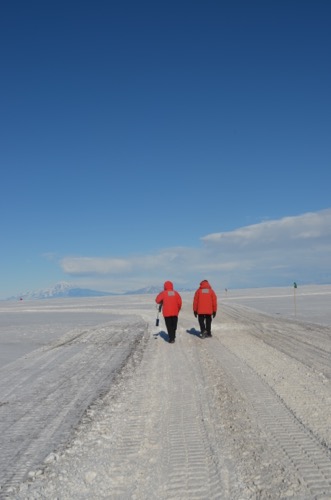
Creating a Vertical Profile
Terry collected data in the water column under the dive hole using a CTDA research tool that is submerged in the water to measure conductivity (salinity), temperature, and depth., which is a water quality sensor that measures conductivity, temperature and depth. Conductivity measures how easily electricity flows through the water. This is related to the amount of salt in the water, along with the water's temperature. Terry's sensor also measures dissolved oxygen levels and pH levels, among other variables.
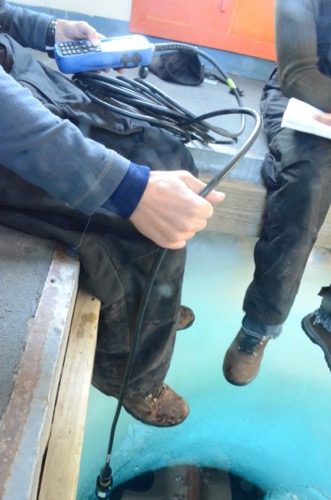
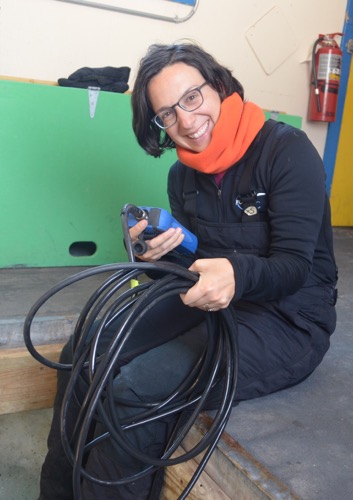
You can use this data to create a vertical profile--a graph that shows how a variable changes with height. Use the data from Terry's CTDA research tool that is submerged in the water to measure conductivity (salinity), temperature, and depth. to create graphs showing how salinity (amount of salt), temperature, oxygen levels and pH change in the sea ice from the surface down. Click here to access the worksheet: graphing_a_vertical_profile_in_mcmurdo_sound.docx
A Science-Lover's Dream
There are so many important science projects happening in McMurdo Station and everyone is happy to talk about their work. When we're all dining in the cafeteria, I often get to hear about science projects that are occurring in and around the station. That is how I heard about Amanda Kelley's work.
Studying Sea Urchins
Amanda is an ecological physiologist. Physiologists study how an organism or a part of an organism works. Ecological physiologists study how organisms function in the context of the environment. Amanda is looking at how sea urchins respond to ocean acidification and warmer ocean temperatures, which are consequences of climate change.
Looking through the Microscope
Today Amanda let me tag along as she checked in on her larval sea urchins. First we looked at her samples through a microscope.
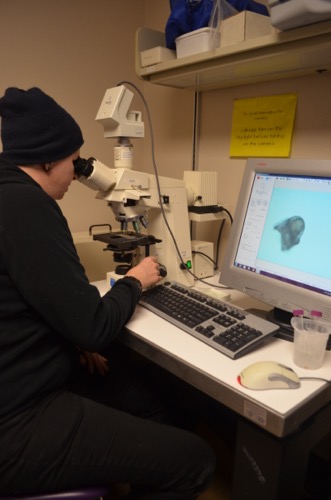
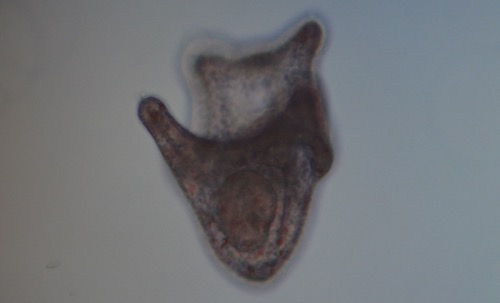
Amanda checks in on her samples to see what stage of development they are in. When we looked, they were about 14 days old and developing four feet. In colder latitudes, everything develops more slowly. Sea urchins in warmer latitudes can develop four feet by three days! Amanda wants to better understand what genes are being turned on and off at different stages of the urchins' development, especially when they are in warmer temperatures and water that is more acidic. When they are at different developmental stages she takes RNA samples of them which will allow her to see these differences.
Calculating Cellular Respiration, Understanding Stress
After checking in on the developmental stage of the sea urchins, Amanda tested the respiration of the larval sea urchins. When you hear "respiration" you may think of breathing. Breathing can play an important role in respiration (specifically aerobic respiration), but the focus is on releasing energy in the cell. The energy gets released through a series of chemical reactions--this is called cellular respiration. In aerobic respiration, which most animals and fungi use, oxygen is used to release that energy. Amanda measures the level of oxygen in the water surrounding the sea urchins to see how well they are respiring. This also helps her understand the sea urchins' metabolic rates. Factors like warmer temperatures or more acidity in the ocean may put stress on sea urchins and affect these levels. This is one of the things that Amanda is studying.
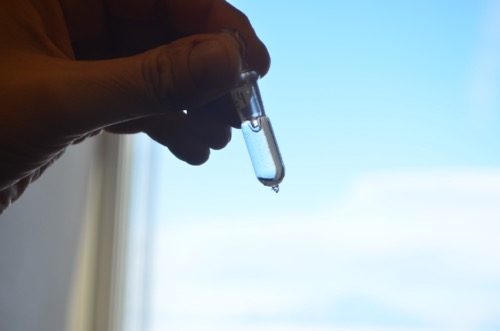
Amanda operates a very precise machine which uses light to calculate the amount of oxygen in the water. Before running the experiment, Amanda reviews a carefully written out procedure. She needs to be sure to replicate each trial exactly the same way so the results of her data are accurate.
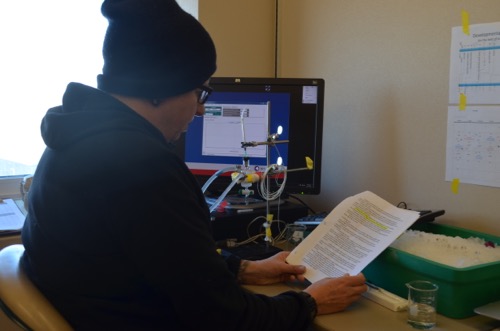
Once the procedure is reviewed, Amanda tests the levels of oxygen in the water surrounding different sea urchin larvae. The first round of tests were from larvae in water that was 2 degrees Celsius--a temperature that sea urchins might experience if the oceans warm. She then tested larvae that were in -1 degree Celsius water, which is closer to their natural habitat. I helped record data, including the time and oxygen values.
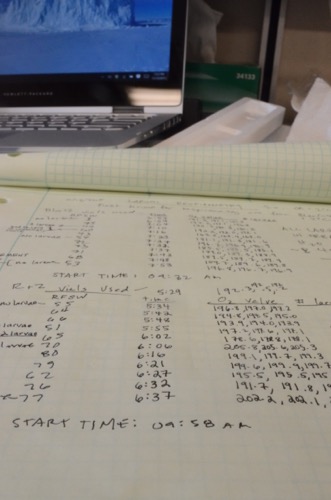
Working Hard for Science
I am so impressed with how dedicated the scientists in McMurdo Station are. Amanda and I collected data until 8 pm--well past dinner! Amanda had been preparing for this experiment for months and it was exciting to be part of getting the results.
Conduct Your Own Sea Urchin & Ocean Acidification Lesson
Amanda not only conducts important research on sea urchins, she also translates her research into inquiry-based lessons for students! Check out the current issue of Science Scope to find a hands-on lesson by Amanda Kelley on sea urchins and climate change (membership is required to access the journal).
Ice Picture of the Day
Today's Picture of the Day is about larval sea urchins! Click here to download a PowerPoint Slide: 10_icepod.pptx
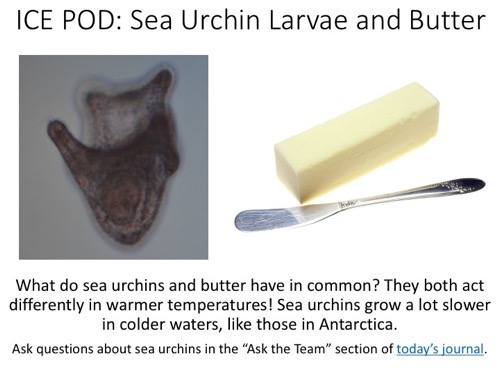
Brought to you by...
Today's journal is brought to you by Dana Carnemolla's class at Eton House, in Surabaya, Indonesia. Thank you for following along with us!

| Attachment | Size |
|---|---|
| graphing_a_vertical_profile_in_mcmurdo_sound.docx547.67 KB | 547.67 KB |
| 10_icepod.pptx283.72 KB | 283.72 KB |

Comments